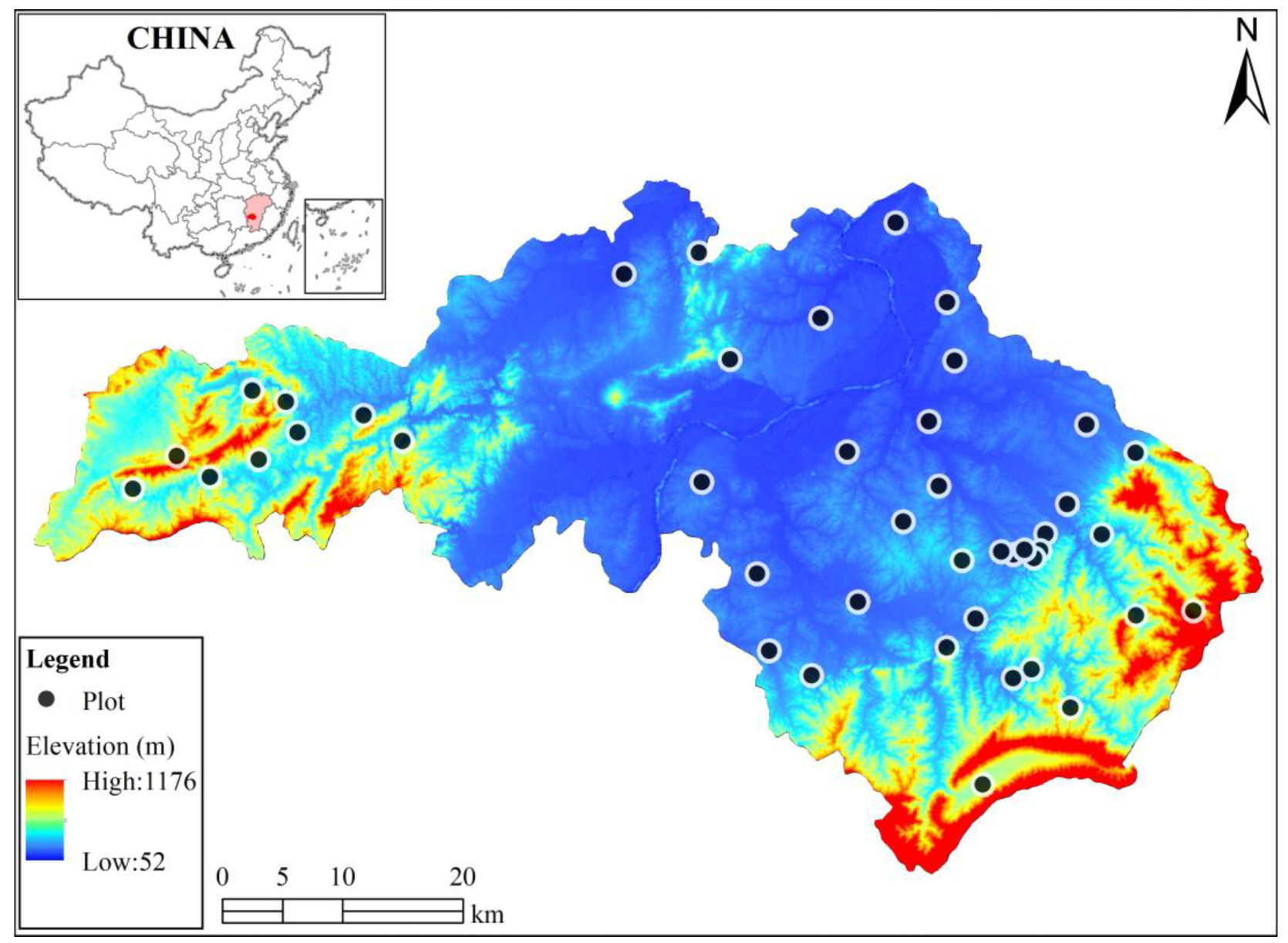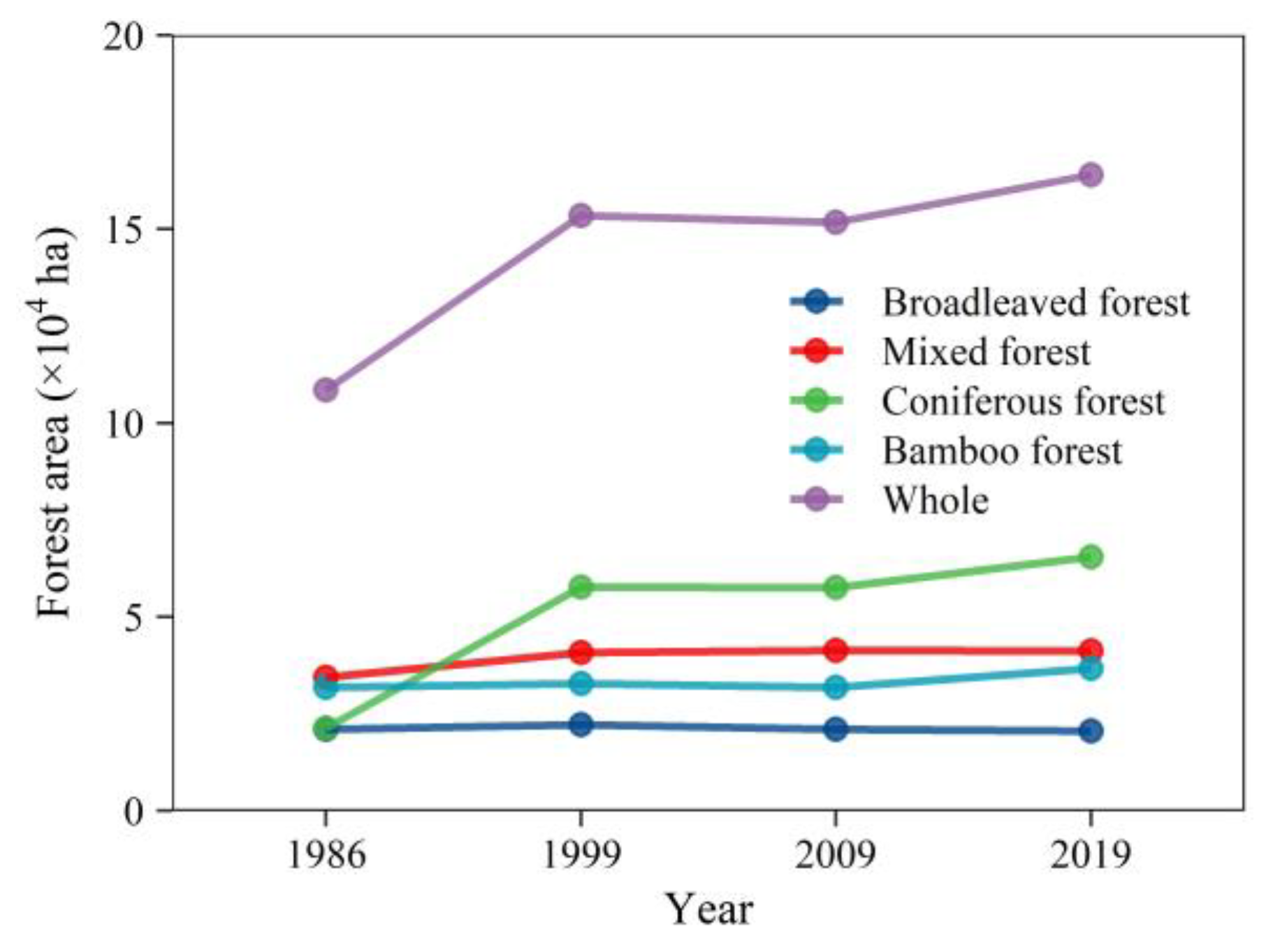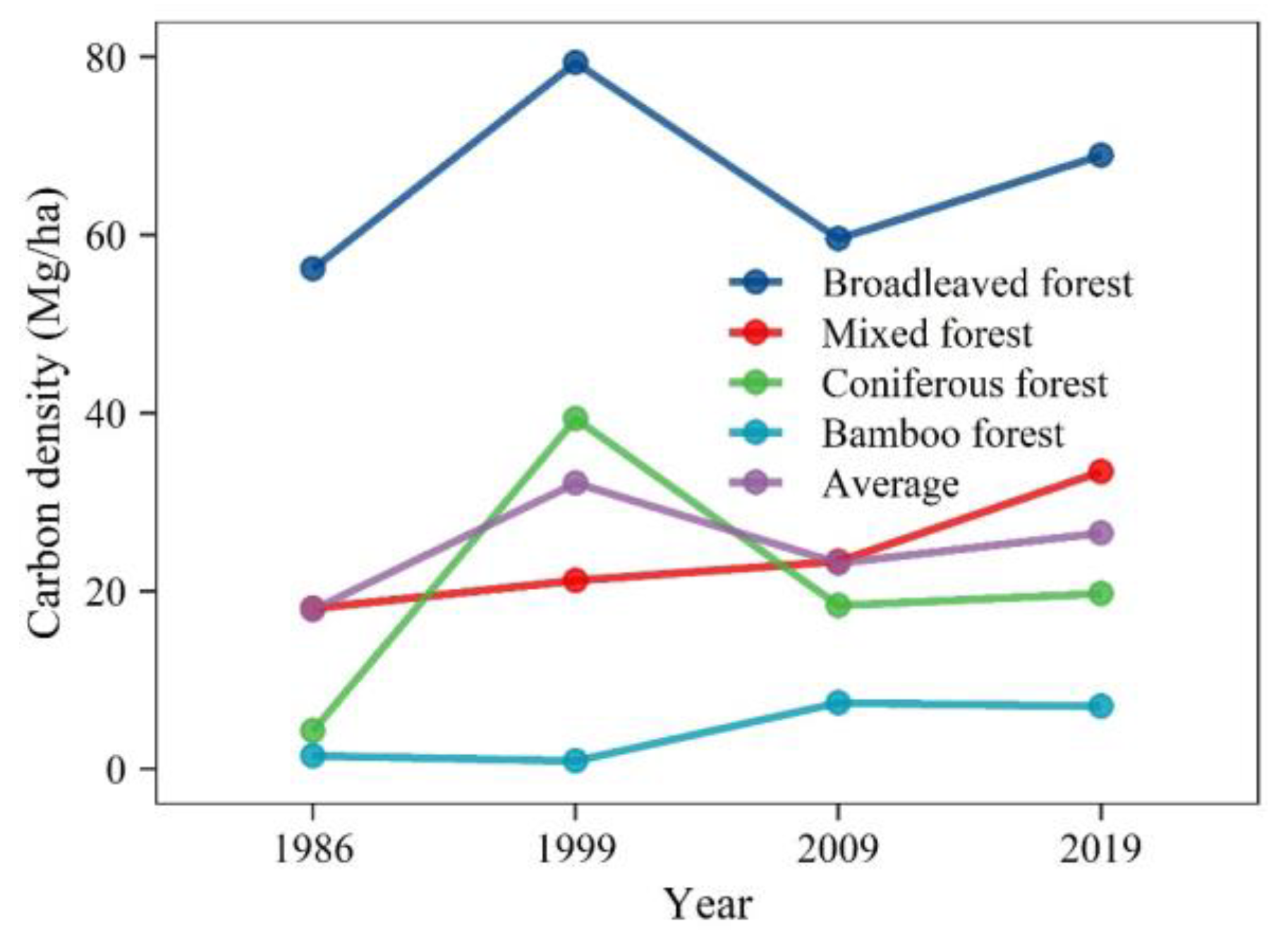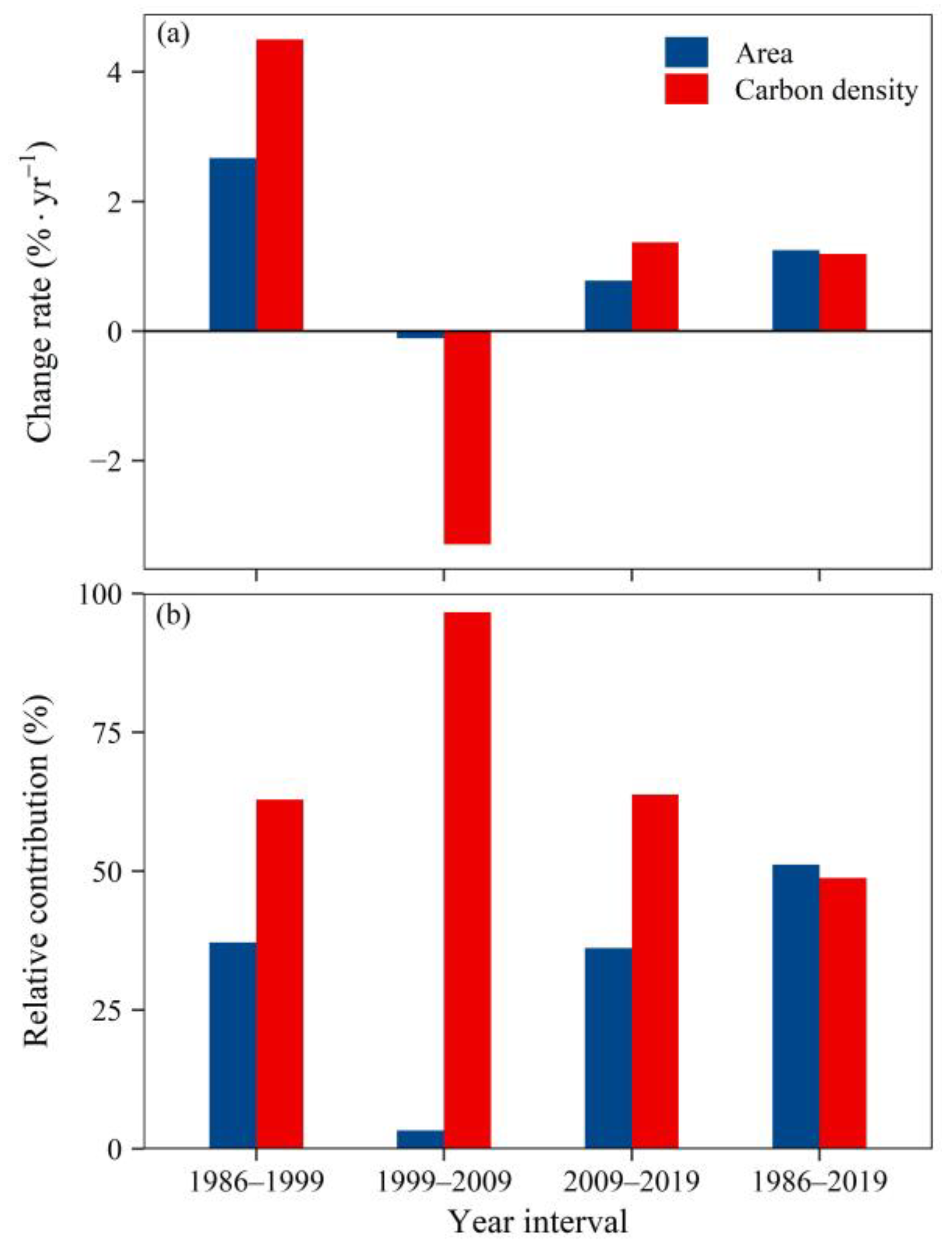Changes in Forest Vegetation Carbon Storage and Its Driving Forces in Subtropical Red Soil Hilly Region over the Past 34 Years: A Case Study of Taihe County, China
Abstract
1. Introduction
2. Materials and Methods
2.1. Study Area
2.2. Data Collection
2.2.1. Field Data
2.2.2. Inventory Data for Forest Management
2.2.3. Remote Sensing Data
2.3. Data Analysis
2.3.1. Field Biomass Estimation
2.3.2. Carbon Storage Estimation of Sub-Compartment
2.3.3. RS Data Preprocessing
2.3.4. Linking RS Data to Forest Vegetation Carbon Storage
2.3.5. Estimation of the Relative Contributions of Forest Area and Vegetation Carbon Density Changes to Vegetation Carbon Storage Variation
3. Results
3.1. Temporal and Spatial Changes in Forest Area
3.2. Changes in Forest Vegetation Carbon Density
3.3. Changes in Forest Vegetation Carbon Storage
3.4. Relative Contributions of Changes in Forest Area and Vegetation Carbon Density to Vegetation Carbon Storage Variation
4. Discussion
5. Conclusions
Author Contributions
Funding
Data Availability Statement
Acknowledgments
Conflicts of Interest
References
- Yang, C.; Shi, Y.; Sun, W.; Zhu, J.; Ji, C.; Feng, Y.; Ma, S.; Guo, Z.; Fang, J. Updated estimation of forest biomass carbon pools in China, 1977–2018. Biogeosciences 2022, 19, 2989–2999. [Google Scholar] [CrossRef]
- Pan, Y.; Birdsey, R.A.; Fang, J.; Houghton, R.; Kauppi, P.E.; Kurz, W.A.; Phillips, O.L.; Shvidenko, A.; Lewis, S.L.; Canadell, J.G.; et al. A Large and persistent carbon sink in the world’s forests. Science 2011, 333, 988–993. [Google Scholar] [CrossRef]
- Pacala, S.W.; Hurtt, G.C.; Baker, D.; Peylin, P.; Houghton, R.A.; Birdsey, R.A.; Heath, L.; Sundquist, E.T.; Stallard, R.F.; Ciais, P.; et al. Consistent Land-and Atmosphere-Based U.S. Carbon Sink Estimates. Science 2001, 292, 2316–2320. [Google Scholar] [CrossRef]
- Guo, Z.; Hu, H.; Li, P.; Li, N.; Fang, J. Spatio-temporal changes in biomass carbon sinks in China’s forests from 1977 to 2008. Sci. China Life Sci. 2013, 56, 661–671. [Google Scholar] [CrossRef]
- Piao, S.; Fang, J.; Zhu, B.; Tan, K. Forest biomass carbon stocks in China over the past 2 decades: Estimation based on integrated inventory and satellite data. J. Geophys. Res. Atmos. 2005, 110, 195–221. [Google Scholar] [CrossRef]
- Dixon, R.K.; Solomon, A.M.; Brown, S.; Houghton, R.A.; Trexier, M.C.; Wisniewski, J. Carbon pools and flux of global forest ecosystems. Science 1994, 263, 185–190. [Google Scholar] [CrossRef] [PubMed]
- Erb, K.-H.; Kastner, T.; Plutzar, C.; Bais, A.L.S.; Carvalhais, N.; Fetzel, T.; Gingrich, S.; Haberl, H.; Lauk, C.; Niedertscheider, M.; et al. Unexpectedly large impact of forest management and grazing on global vegetation biomass. Nature 2017, 553, 73–76. [Google Scholar] [CrossRef]
- Piao, S.; Fang, J.; Ciais, P.; Peylin, P.; Huang, Y.; Sitch, S.; Wang, T. The carbon balance of terrestrial ecosystems in China. Nature 2009, 458, 1009–1013. [Google Scholar] [CrossRef] [PubMed]
- Fang, J.; Chen, A.; Peng, C.; Zhao, S.; Ci, L. Changes in forest biomass carbon storage in china between 1949 and 1998. Science 2001, 292, 2320–2322. [Google Scholar] [CrossRef]
- FAO. Global Forest Resources Assessment 2020: Main Report; FAO: Rome, Italy, 2020. [Google Scholar]
- Zhang, P.; Shao, G.; Zhao, G.; Le Master, D.C.; Parker, G.R.; Dunning, J.B.; Li, Q. Ecology—China’s forest policy for the 21st century. Science 2000, 288, 2135–2136. [Google Scholar] [CrossRef] [PubMed]
- Zhao, M.; Yang, J.; Zhao, N.; Liu, L.; DU, L.; Xiao, X.; Yue, T.; Wilson, J.P. Spatially explicit changes in forest biomass carbon of China over the past 4 decades: Coupling long-term inventory and remote sensing data. J. Clean. Prod. 2021, 316, 128274. [Google Scholar] [CrossRef]
- Fang, J.; Yu, G.; Liu, L.; Hu, S.; Chapin, F.S. Climate change, human impacts, and carbon sequestration in China. Proc. Natl. Acad. Sci. USA 2018, 115, 4015–4020. [Google Scholar] [CrossRef] [PubMed]
- Pan, Y.; Luo, T.; Birdsey, R.; Hom, J.; Melillo, J. New estimates of carbon storage and sequestration in China’s Forests: Effects of age-class and method on inventory-based carbon estimation. Clim. Chang. 2004, 67, 211–236. [Google Scholar] [CrossRef]
- Hua, F.; Wang, X.; Zheng, X.; Fisher, B.; Wang, L.; Zhu, J.; Tang, Y.; Yu, D.W.; Wilcove, D.S. Opportunities for biodiversity gains under the world’s largest reforestation programme. Nat. Commun. 2016, 7, 12717. [Google Scholar] [CrossRef] [PubMed]
- Xu, J. China’s new forests aren’t as green as they seem. Nature 2011, 477, 370. [Google Scholar] [CrossRef] [PubMed]
- Tong, X.; Brandt, M.; Yue, Y.; Ciais, P.; Rudbeck Jepsen, M.; Penuelas, J.; Wigneron, J.-P.; Xiao, X.-P.; Song, X.-P.; Horion, S.; et al. Forest management in southern China generates short term extensive carbon sequestration. Nat. Commun. 2020, 11, 129. [Google Scholar] [CrossRef]
- Fang, J.; Guo, Z.; Hu, H.; Kato, T.; Muraoka, H.; Son, Y. Forest biomass carbon sinks in East Asia, with special reference to the relative contributions of forest expansion and forest growth. Glob. Chang. Biol. 2014, 20, 2019–2030. [Google Scholar] [CrossRef]
- Kauppi, P.E.; Ausubel, J.H.; Fang, J.Y.; Mather, A.S.; Sedjo, R.A.; Waggoner, P.E. Returning forests analyzed with the forest identity. Proc. Ntal. Acad. Sci. USA 2006, 103, 17574–17579. [Google Scholar] [CrossRef] [PubMed]
- Zhao, M.; Yang, J.; Zhao, N.; Xiao, X.; Yue, T.; Wilson, J.P. Estimation of the relative contributions of forest areal expansion and growth to China’s forest stand biomass carbon sequestration from 1977 to 2018. J. Environ. Manag. 2021, 300, 113757. [Google Scholar] [CrossRef]
- Li, P.; Zhu, J.; Hu, H.; Guo, Z.; Pan, Y.; Birdsey, R.; Fang, J. The relative contributions of forest growth and areal expansion to forest biomass carbon. Biogeosciences 2016, 13, 375–388. [Google Scholar] [CrossRef]
- Zeng, W.; Zhou, Y. Discussion on main problems and countermeasures to continuous forest inventory and forest management inventory. Cent. South For. Inventory Plan. 2003, 22, 8–11. (In Chinese) [Google Scholar]
- Zhao, M.; Yang, J.; Zhao, N.; Liu, Y.; Wang, Y.; Wilson, J.P.; Yue, T. Estimation of China’s forest stand biomass carbon sequestration based on the continuous biomass expansion factor model and seven forest inventories from 1977 to 2013. For. Ecol. Manag. 2019, 448, 528–534. [Google Scholar] [CrossRef]
- Xu, X.; Cao, M.; Li, K. Temporal-spatial dynamics of carbon storage of forest vegetation in China. Prog. Geogr. 2007, 26, 1–10. (In Chinese) [Google Scholar]
- Wang, X.; Feng, Z.; Ouyang, Z. The impact of human disturbance on vegetative carbon storage in forest ecosystems in China. For. Ecol. Manag. 2001, 148, 117–123. [Google Scholar] [CrossRef]
- Chen, S.; Jiang, H.; Jin, J.; Wang, Y. Changes in net primary production in the Tianmu Mountain Nature Reserve, China, from 1984 to 2014. Int. J. Remote. Sens. 2016, 38, 211–234. [Google Scholar] [CrossRef]
- Yang, X.; Blagodatsky, S.; Lippe, M.; Liu, F.; Hammond, J.; Xu, J.; Cadisch, G. Land-use change impact on time-averaged carbon balances: Rubber expansion and reforestation in a biosphere reserve, South-West China. For. Ecol. Manag. 2016, 372, 149–163. [Google Scholar] [CrossRef]
- Jiang, G.; Han, B.; Gao, Y.; Yang, C. Review of 40-year earth observation with Landsat series and prospects of LDCM. J. Remote Sens. 2013, 17, 1033–1048. [Google Scholar]
- Xiang, W.; Zhou, J.; Ouyang, S.; Zhang, S.; Lei, P.; Li, J.; Deng, X.; Fang, X.; Forrester, D.I. Species-specific and general allometric equations for estimating tree biomass components of subtropical forests in southern China. Eur. J. For. Res. 2016, 135, 963–979. [Google Scholar] [CrossRef]
- Wang, Z.; Du, H.; Song, T.; Peng, W.; Zeng, F.; Zeng, Z.; Zhang, H. Allometric models of major tree species and forest biomass in Guangxi. Acta Ecologica Sinica 2015, 35, 4462–4472. (In Chinese) [Google Scholar]
- Zuo, S.-D.; Ren, Y.; Weng, X.; Ding, H.-F.; Luo, Y.-J. Biomass allometric equations of nine common tree species in an evergreen broadleaved forest of subtropical China. Yingyong Shengtai Xuebao. 2015, 26, 356–362. [Google Scholar]
- Ma, Z.; Liu, Q.; Xu, W.; Li, X.; Liu, Y. Carbon storage of artificial forest in Qianyanzhou, Jiangxi province. Sci. Silvae Sin. 2007, 43, 1–7. (In Chinese) [Google Scholar]
- Zhou, H.; Meng, S.; Liu, Q. Allometric equations for estimating aboveground biomass of broad-leaved forests saplings and shrubs in subtropical China. J. Nanjing For. Univ. (Nat. Sci. Ed.) 2017, 41, 79–86. (In Chinese) [Google Scholar]
- Chen, F.; Luo, Y.; Li, Q. Allometric equations for estimating biomass of dominant shrub species in subtropical forests in eastern Guangdong Province, China. J. Cent. South Univ. For. Technol. 2013, 33, 5–10. (In Chinese) [Google Scholar]
- Li, Y.; Zheng, S.; Gong, G.; Chen, J.; Tang, B.; Zhu, Z.; Wu, X.; Mu, C. Biomass and its allocation of undergrowth Vitex negundo L. in different age classes of mixed cypress forest. Acta Ecologica Sinica 2010, 30, 2809–2818. (In Chinese) [Google Scholar]
- Zhang, H.; Liu, Q.; Lu, P.; Yu, Q.; Zeng, H. Biomass estimation of several common shrubs in Qianyanzhou experimental station. For. Inventory Plan. 2005, 30, 43–49. (In Chinese) [Google Scholar]
- Luo, Y.; Wang, X.; Zhang, X. Biomass and Its Allocation In Forest Ecosystems in China; Forestry Publishing House: Beijing, China, 2013. (In Chinese) [Google Scholar]
- Gamon, J.A.; Field, C.B.; Goulden, M.L.; Griffin, K.L.; Hartley, A.E.; Joel, G.; Penuelas, J.; Valentini, R. Relationships between NDVI, canopy structure, and photosynthesis in three californian vegetation types. Ecol. Appl. 1995, 5, 28–41. [Google Scholar] [CrossRef]
- Jordan C, F. Derivation of leaf-area index from quality of light on the forest floor. Ecology 1969, 50, 663–666. [Google Scholar] [CrossRef]
- Tucker C, J. Red and photographic infrared linear combinations for monitoring vegetation. Remote Sens. Environ. 1979, 8, 127–150. [Google Scholar] [CrossRef]
- Dorren, L.K.A.; Maier, B.; Seijmonsbergen, A.C. Improved Landsat-based forest mapping in steep mountainous terrain using object-based classification. For. Ecol. Manag. 2003, 183, 31–46. [Google Scholar] [CrossRef]
- Breiman, L. Random forests. Mach. Learn 2001, 45, 5–32. [Google Scholar] [CrossRef]
- Safavian, S.; Landgrebe, D. A survey of decision tree classifier methodology. IEEE Trans. Syst. Man Cybern. 1991, 21, 660–674. [Google Scholar] [CrossRef]
- Franklin, J. Predictive vegetation mapping: Geographic modelling of biospatial patterns in relation to environmental gradients. Prog. Phys. Geogr. Earth Environ. 1995, 19, 474–499. [Google Scholar] [CrossRef]
- Rodriguez-Galiano, V.F.; Ghimire, B.; Rogan, J.; Chica-Olmo, M.; Rigol-Sanchez, J.P. An assessment of the effectiveness of a random forest classifier for land-cover classification. ISPRS J. Photogramm. Remote Sens. 2012, 67, 93–104. [Google Scholar] [CrossRef]
- Friedl, M.; Brodley, C. Decision tree classification of land cover from remotely sensed data. Remote. Sens. Environ. 1997, 61, 399–409. [Google Scholar] [CrossRef]
- Paola, J.D.; Schowengerdt, R.A. A review and analysis of backpropagation neural networks for classification of remotely-sensed multi-spectral imagery. Int. J. Remote Sens. 1995, 16, 3033–3058. [Google Scholar] [CrossRef]
- Gislason, P.O.; Benediktsson, J.A.; Sveinsson, J.R. Random Forests for land cover classification. Pattern Recognit. Lett. 2006, 27, 294–300. [Google Scholar] [CrossRef]
- Richards, J.A. Remote Sensing Digital Image Analysis: An Introduction, 5th ed.; Springer: Berlin/Heidelberg, Germany, 2013. [Google Scholar]
- Crist, E.P.; Cicone, R.C. Application of the tasseled cap concept to simulated thematic mapper data. Photogramm. Eng. Remote Sens. 1984, 50, 343–352. [Google Scholar]
- Nanni, L.; Brahnam, S.; Ghidoni, S.; Menegatti, E.; Barrier, T. Different approaches for extracting information from the co-occurrence matrix. PLoS ONE 2013, 8, e83554. [Google Scholar] [CrossRef]
- Fisher, R.A.; Yates, F. Statistical Tables for Biological, Agricultural and Medical Research; Oliver and Boyd: Edinburgh/London, UK, 1938. [Google Scholar]
- Hubbard, R.; Bayarri, M.J. Confusion over measures of evidence (p’s) versus errors (α’s) in classical statistical testing. Am. Stat. 2003, 57, 171–178. [Google Scholar] [CrossRef]
- Papale, D.; Valentini, A. A new assessment of European forests carbon exchanges by eddy fluxes and artificial neural network spatialization. Glob. Change Biol. 2003, 9, 525–535.41. [Google Scholar] [CrossRef]
- Waggoner, P.E. Using the forest Identity to grasp and comprehend the swelling mass of forest statistics. Int. For. Rev. 2008, 10, 689–694. [Google Scholar] [CrossRef]
- Chen, C.; Park, T.; Wang, X.; Piao, S.; Xu, B.; Chaturvedi, R.K.; Fuchs, R.; Brovkin, V.; Ciais, P.; Fensholt, R.; et al. China and India lead in greening of the world through land-use management. Nat. Sustain. 2019, 2, 122–129. [Google Scholar] [CrossRef] [PubMed]
- Yu, G.; Chen, Z.; Piao, S.; Peng, C.; Ciais, P.; Wang, Q.; Li, X.; Zhu, X. High carbon dioxide uptake by subtropical forest ecosystems in the East Asian monsoon region. Proc. Natl. Acad. Sci. USA 2014, 111, 4910–4915. [Google Scholar] [CrossRef] [PubMed]
- Brown, S.; Schroeder, P.; Birdsey, R. Aboveground biomass distribution of US eastern hardwood forests and the use of large trees as an indicator of forest development. For. Ecol. Manag. 1997, 96, 37–47. [Google Scholar] [CrossRef]
- Fang, J.; Piao, S.; He, J.; Ma, W. Increasing terrestrial vegetation activity in China, 1982–1999. Sci. China Life Sci. 2004, 47, 229–240. [Google Scholar] [CrossRef]
- Zhang, C.; Ju, W.; Chen, J.M.; Wang, X.; Yang, L.; Zheng, G. Disturbance-induced reduction of biomass carbon sinks of China’s forests in recent years. Environ. Res. Lett. 2015, 10, 114021. [Google Scholar] [CrossRef]
- Sheng, W. On the maintenance of Long-term productivity of plantation in China. For. Res. 2018, 31, 1–14. (In Chinese) [Google Scholar]
- Bryan, B.A.; Gao, L.; Ye, Y.; Sun, X.; Connor, J.D.; Crossman, N.D.; Stafford-Smith, M.; Wu, J.; He, C.; Yu, D.; et al. China’s response to a national land-system sustainability emergency. Nature 2018, 559, 193–204. [Google Scholar] [CrossRef]
- Wang, X.; Huang, S.; Li, J.; Zhou, G.; Shi, L. Sprouting response of an evergreen broad-leaved forest to a 2008 winter storm in Nanling Mountains, southern China. Ecosphere 2016, 7, e01395. [Google Scholar] [CrossRef]
- Ma, Z.; Wang, H.; Wang, S.; Li, Q.; Wang, Y.; Wang, H. Impact of a severe ice storm on subtropical plantations at Qianyanzhou, Jiangxi, China. Chin. J. Plant Ecol. 2010, 34, 204–212. (In Chinese) [Google Scholar]
- Zhou, S. Deepening understanding and classification guidance to fight the tough battle of forestry development in the phase of staid. For. China 2005, 8, 4–11. (In Chinese) [Google Scholar]
- Wang, G.; Innes, J.L.; Lei, J.; Dai, S.; Wu, S. Ecology—China’s forestry reforms. Science 2007, 318, 1556–1557. [Google Scholar] [CrossRef]
- Xu, J.; Hyde, W.F. China’s second round of forest reforms: Observations for China and implications globally. For. Policy Econ. 2019, 98, 19–29. [Google Scholar] [CrossRef]
- Holtmann, A.; Huth, A.; Pohl, F.; Rebmann, C.; Fischer, R. Carbon sequestration in mixed deciduous forests: The influence of tree size and species composition derived from model experiments. Forests 2021, 12, 24. [Google Scholar] [CrossRef]
- Pizarro, S.E.; Pricope, N.G.; Vargas-Machuca, D.; Huanca, O.; Ñaupari, J. Mapping land cover types for highland Andean ecosystems in Peru using google earth engine. Remote. Sens. 2022, 14, 1562. [Google Scholar] [CrossRef]
- Li, Y.; Li, C.; Li, M.; Liu, Z. Influence of variable selection and forest type on forest aboveground biomass estimation using machine learning algorithms. Forests 2019, 10, 24. [Google Scholar] [CrossRef]







| Forest Types | Diameter (cm) | Stand Density (trees/ha) | Volume (m3/ha) | Carbon Storage (Mg/ha) | Sample Size | ||
|---|---|---|---|---|---|---|---|
| Arbor Layer | Shrub Layer | Herb Layer | |||||
| Slash pine forest | 13.62 (±3.41) | 1175 (±419) | 145.00 (±70.73) | 25.45 (±9.64) | 7.22 (±6.62) | 2.14 (±0.65) | 14 |
| Chinese fir forest | 12.60 (±2.24) | 2631 (±968) | 172.67 (±56.24) | 35.97 (±11.42) | 3.95 (±3.76) | 1.82 (±1.13) | 9 |
| Masson pine forest | 8.31 (±3.36) | 1465 (±685) | 58.77 (±37.82) | 21.35 (±13.49) | 10.25 (±11.34) | 1.83 (±0.48) | 5 |
| Broadleaved forest | 18.80 (±3.36) | 1306 (±699) | 215.64 (±102.43) | 119.27 (±57.54) | 0.13 (±0.07) | 1.16 (±0.34) | 9 |
| Mixed forest | 12.21 (±3.11) | 1350 (±620) | 105.83 (±55.58) | 44.84 (±28.66) | 17.39 (±25.89) | 2.15 (±1.35) | 5 |
| Bamboo forest | 9.60 (±0.29) | 2700 (±535) | 46.31 (±6.78) | 27.36 (±4.24) | 1.55 (±0.72) | 1.30 (±0.52) | 3 |
| Forest Types | Model Expression | R2 | RMSE (Mg/ha) |
|---|---|---|---|
| Slash pine forest | W = 0.326V + 14.197 | 0.980 | 2.710 |
| Chinese fir forest | W = 0.489V + 2.358 | 0.996 | 1.517 |
| Masson pine forest | W = 0.860V + 0.949 | 0.999 | 0.707 |
| Broadleaved forest | W = 1.846V − 71.245 | 0.851 | 58.131 |
| Mixed forest | W = 1.101V − 8.260 | 0.782 | 26.771 |
| Bamboo forest | W = 1.585V − 3.089 | 0.975 | 1.333 |
| Classifier | Total Accuracy | Kappa Coefficient |
|---|---|---|
| Decision tree | 76.8% | 0.759 |
| Random forest | 83.2% | 0.804 |
| BP neural network | 62.0% | 0.538 |
| Variable Type | Variable Number | Variable Name | Description |
|---|---|---|---|
| Band image | 6 | B1 | Blue (0.45~0.52 μm) |
| B2 | Green (0.52~0.60 μm) | ||
| B3 | Red (0.63~0.69 μm) | ||
| B4 | NIR (0.76~0.90 μm) | ||
| B5 | SWIR1 (1.55~1.75 μm) | ||
| B6 | SWIR2 (2.09~2.35 μm) | ||
| Principal components transformation | 3 | PC1, PC2, and PC3 | First, second, and third bands from principal component analysis |
| Tasseled cap transformation | 3 | Brightness, greenness, and wetness | Three bands produced by tasseled cap transformation |
| Vegetation index | 15 | DVI | Difference vegetation index |
| EVI | Enhanced vegetation index | ||
| GARI | Green atmospherically resistant index | ||
| GDVI | Green difference vegetation index | ||
| GNDVI | Green normalized difference Vegetation index | ||
| GRVI | Green ratio vegetation index | ||
| IPVI | Infrared percentage vegetation index | ||
| LAI | Leaf area index | ||
| NDVI | Normalized difference vegetation index | ||
| OSAVI | Optimized soil-adjusted vegetation index | ||
| RDVI | Renormalized difference vegetation index | ||
| RVI | Ratio vegetation index | ||
| SAVI | Soil-adjusted vegetation index | ||
| TDVI | Transformed difference vegetation index | ||
| VARI | Visible atmospherically resistant index | ||
| Texture image | 144 | BiTjMea, BiTjVar, BiTjHom, BiTjCon, BiTjDis, BiTjEnt, BiTjSem, and BiTjCor | Bands 1–6 texture measurement Using gray-level co-occurrence matrix |
| Terrain image | 3 | DEM, slope, and aspect | Extraction based on DEM |
| Forest Types | Sample Size | |||
|---|---|---|---|---|
| Total | Training | Validation | Test | |
| Coniferous forest | 5006 | 3504 | 751 | 751 |
| Broadleaved forest | 2227 | 1559 | 334 | 334 |
| Mixed forest | 1293 | 905 | 194 | 194 |
| Bamboo forest | 480 | 336 | 72 | 72 |
Disclaimer/Publisher’s Note: The statements, opinions and data contained in all publications are solely those of the individual author(s) and contributor(s) and not of MDPI and/or the editor(s). MDPI and/or the editor(s) disclaim responsibility for any injury to people or property resulting from any ideas, methods, instructions or products referred to in the content. |
© 2023 by the authors. Licensee MDPI, Basel, Switzerland. This article is an open access article distributed under the terms and conditions of the Creative Commons Attribution (CC BY) license (https://creativecommons.org/licenses/by/4.0/).
Share and Cite
Yan, L.; Meng, S.; Yang, F.; Dai, X.; Wang, H. Changes in Forest Vegetation Carbon Storage and Its Driving Forces in Subtropical Red Soil Hilly Region over the Past 34 Years: A Case Study of Taihe County, China. Forests 2023, 14, 602. https://doi.org/10.3390/f14030602
Yan L, Meng S, Yang F, Dai X, Wang H. Changes in Forest Vegetation Carbon Storage and Its Driving Forces in Subtropical Red Soil Hilly Region over the Past 34 Years: A Case Study of Taihe County, China. Forests. 2023; 14(3):602. https://doi.org/10.3390/f14030602
Chicago/Turabian StyleYan, Lingyuan, Shengwang Meng, Fengting Yang, Xiaoqin Dai, and Huimin Wang. 2023. "Changes in Forest Vegetation Carbon Storage and Its Driving Forces in Subtropical Red Soil Hilly Region over the Past 34 Years: A Case Study of Taihe County, China" Forests 14, no. 3: 602. https://doi.org/10.3390/f14030602
APA StyleYan, L., Meng, S., Yang, F., Dai, X., & Wang, H. (2023). Changes in Forest Vegetation Carbon Storage and Its Driving Forces in Subtropical Red Soil Hilly Region over the Past 34 Years: A Case Study of Taihe County, China. Forests, 14(3), 602. https://doi.org/10.3390/f14030602







